New Boston Historical Society
New Boston, New Hampshire
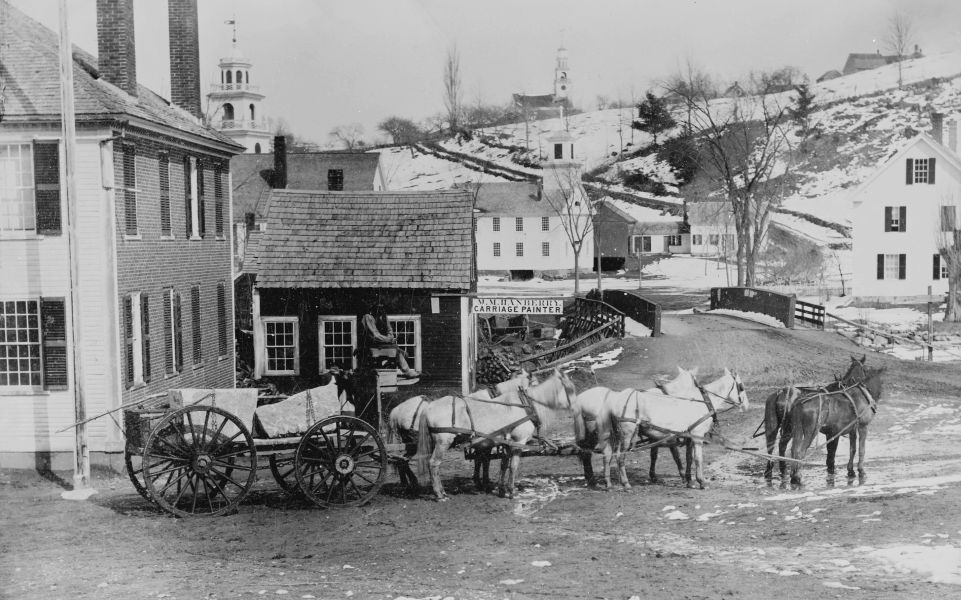 A wagonload of Francestown soapstone approaches the Central Square bridge in New Boston.
A wagonload of Francestown soapstone approaches the Central Square bridge in New Boston.
A Wagonload of Soapstone
C.H. Dodge and a Francestown quarry

The same view today. Dodge's Store is the large red building visible beyond the white TD Bank and the Garden Center.
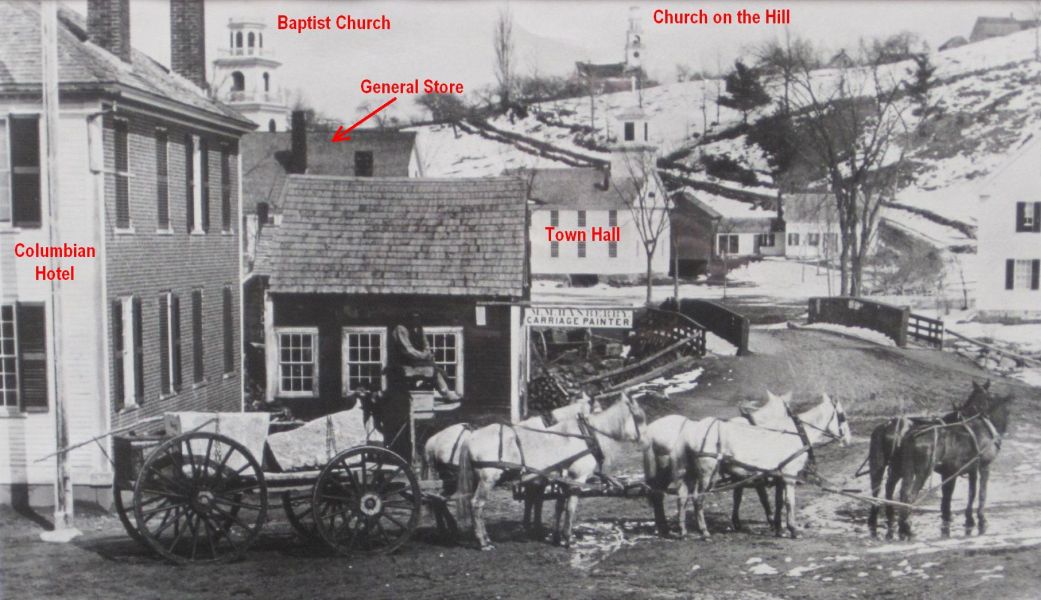
Across the bridge you can see three steeples belonging to the Baptist Church and the Town Hall, both of which burned in the Fire of 1887, and the Church on the Hill, which burned in 1900.
To the left of the wagon on this side of the river is the Columbian Hotel, later called The Tavern.
I have searched mightily for information about the business of "M.M. Hanberry, Carriage Painter" next to the bridge, to no avail.

Soapstone quarry on Bible Hill Road
(Photos courtesy of the Francestown Heritage Museum)
Before you write to tell me that Bible Hill Road is in Francestown, please note that a large part of Francestown was originally part of New Boston, including Bible Hill and Scoby Pond, too. A few years before the American Revolution, the residents petitioned the Royal Governor to separate the "Francestown addition" from New Boston, as it was too far for them to go to church in our meetinghouse, seven miles away. Prior to this successful petition in 1772, New Boston's western-most boundary was what later became known as Mill Village in Francestown.
Where was Mill Village? Drive west from New Boston to Francestown on Route 136, and you'll pass a historic marker labeled "Soapstone" after you cross the Piscataquog River, just before Francestown center, and that was Mill Village. There's still a soapstone saw-mill there, as of February 2020, but it may not survive the next big snowfall.
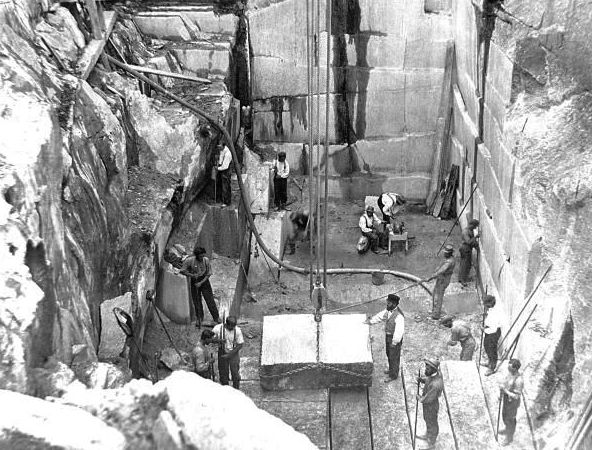
Soapstone quarry in the 1800s
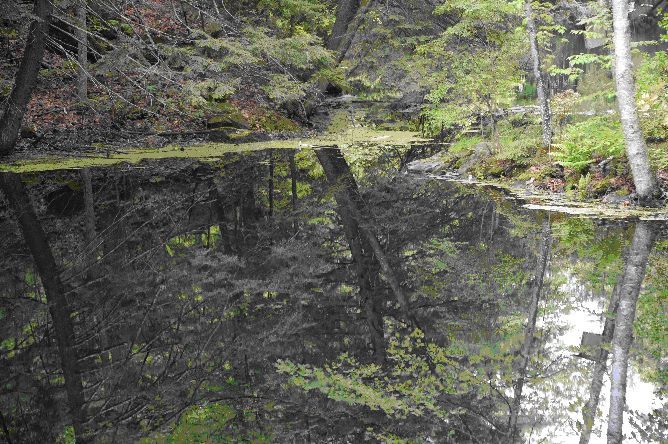
Soapstone quarry today - that water is very, very deep!
John R. Schott wrote in his 1972 history "Frances' Town" that after the Civil War, "Four six-horse teams running continually all summer long conveyed twenty tons of [soapstone] to the Boston market daily."
Eventually the soapstone quarry was 134 feet deep — imagine if you will the height of a 13-story building, underground. After the best stone was hauled away by horses and oxen, it became less economical to operate the quarry. The last man to try to make the business profitable was a New Boston storekeeper named Clarence H. Dodge.
Clarence H. Dodge, storekeeper
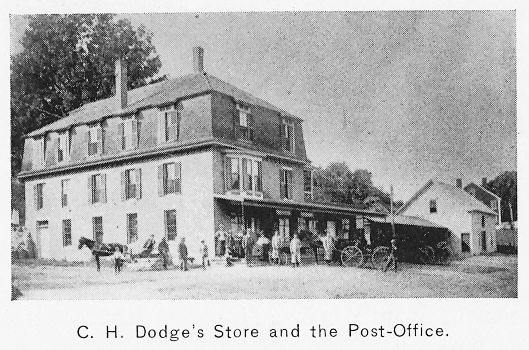
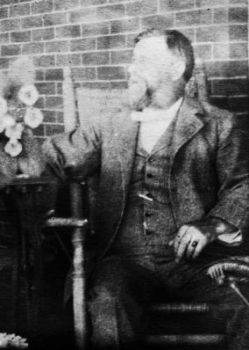
C.H. Dodge's first store in New Boston, across from The Tavern, and the storekeeper himself in 1904.
Four generations of Dodges have owned a general store in our town: Clarence, Ben, Homer, and Josh. A fifth generation Dodge worked in the store as a young man, but he declined the opportunity to own it. (It was John William Jenkinson who lent me the photo of his great-great-grandfather Clarence H. Dodge.)
Clarence Dodge was born in New Boston in 1848, and he'd been a storekeeper for two years by the time he married Jennie Smith in 1874. Now, everyone in New Boston knows Dodge's Store, the general store in our village center which was built after the Fire of 1887, but that was actually Atwood's Store at the time of our soapstone story. Clarence Dodge didn't buy that building until 1920; his first store was located in the brick building opposite the Columbian Hotel / The Tavern / TD Bank. It's now a private home at the corner of Clark Hill Road and High Street. (You can read more about New Boston's general stores elsewhere on this site.)
In 1906, when Clarence Dodge was 58 years old, he and his partners formed "The New Francestown Soapstone Company" to operate the Bible Hill quarry. Why did this successful storekeeper decide to go into the soapstone business? I don't know!
In May of 1912 Clarence decided to blast open a new vein of soapstone across Bible Hill Road from the old quarry, which had filled with water. Alas, Clarence used too much dynamite — all of the Soapstone Company's buildings and two of the neighbors' farmhouses were demolished by the blast! There are no reports of death or injury, but the lawsuits which followed put an end to soapstone quarrying in Francestown, which is why wagons laden with stone no longer rumble through New Boston village.

The soapstone saw-mill in Mill Village several years ago, when its walls were vertical.

The up & down saw once was powered by a waterwheel.
P.S. If you'd like to receive their free monthly e-newsletter, email the FHM curator/editor Bill McAuley wfm03043@comcast.net.
